Johannes Bosboom
Johannes Bosboom (born The Hague, February 18, 1817 – died there September 14, 1891) was a Dutch painter and watercolorist of the Hague School, known especially for his paintings of church interiors.
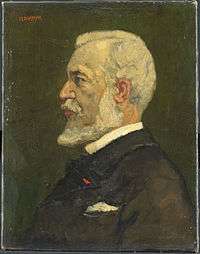
by Charles Dankmeijer
Biography
At the age of 14 he became a student of Bartholomeus van Hove and painted in his studio along with Van Hove's son Hubertus van Hove. Together they worked on the pieces of scenery that Van Hove created for the Royal Theatre in The Hague. In addition, Bosboom took lessons from 1831 to 1835 and again from 1839 to 1840 in the Hague Academy of Art. Here he also made the acquaintance of Anthonie Waldorp and Wijnand Nuyen.
The young Bosboom traveled to Germany in 1835 to Düsseldorf, Cologne and Koblenz and painted the watercolor View of the Mosel Bridge at Koblenz. This painting was purchased by Andreas Schelfhout, who became his confidante and friend. In 1839 he traveled to Paris and Rouen and received a silver medal for View of the Paris Quay and the Cathedral at Rouen. He also painted a number of church interiors, a relatively traditional genre in which the seventeenth century artists Pieter Saenredam and Emanuel de Witte served as important examples. Bosboom had a great deal of success with these pieces, and for the rest of his career he would repeatedly return to this theme, which was the one in which he would achieve his greatest fame.
Bosboom's choice of subject matter may seem to isolate him from the rest of the Hague School, but his search for ways to reproduce the spatial atmosphere through light, shadow, and nuances of color places him in the very mainstream of this group. In 1873, during a stay in Scheveningen, he painted many watercolors of town views, the dunes, the beach and the sea. It is possible that these watercolors encouraged Hendrik Willem Mesdag and Jacob Maris to concentrate further on the sea and beach as subjects.
Honours
1886: Officer in the Order of Leopold.[1]
Gallery
 Bakenesserkerk Interior (1870). Dordrecht's Museum aan de Haven.
Bakenesserkerk Interior (1870). Dordrecht's Museum aan de Haven.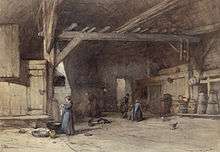 Interieur van een boerendeel bij Hilversum
Interieur van een boerendeel bij Hilversum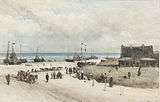 Het strand te Scheveningen
Het strand te Scheveningen Gezicht te Koblenz (watercolor)
Gezicht te Koblenz (watercolor).jpg) Gezicht te Koblenz (1835)
Gezicht te Koblenz (1835)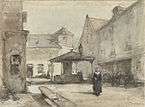 Stadspleintje
Stadspleintje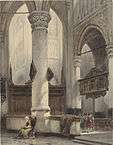 Interieur van de Nieuwe Kerk te Delft
Interieur van de Nieuwe Kerk te Delft
References
- Handelsblad (Het) 11-03-1886
Sources
- Sillevis, John and Tabak, Anne, The Hague School Book, Waanders Uitgegevers, Zwolle, 2004 (pp 195–203)
External links
| Wikiquote has quotations related to: Johannes Bosboom |

- 5 paintings by or after Johannes Bosboom at the Art UK site
- biography facts and dates of J. Bosboom at the Dutch R.K.D.
- Johannes Bosboom, by Gerarda Hermina Marius - in free pdf; publish, M. Nijhoff, 1917, 's-Gravenhage / The Hague
- many images of Bosboom's art, in the Rijksmuseum of Amsterdam